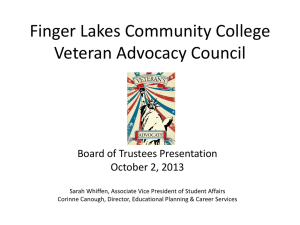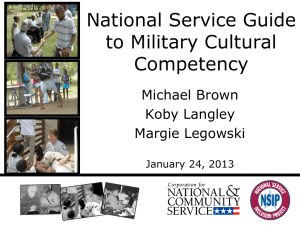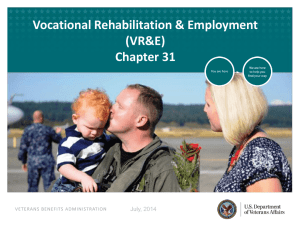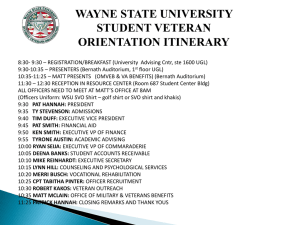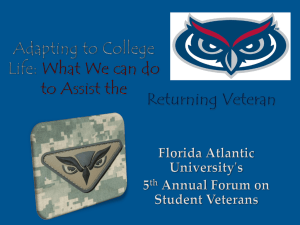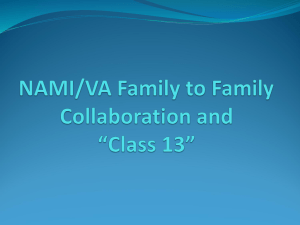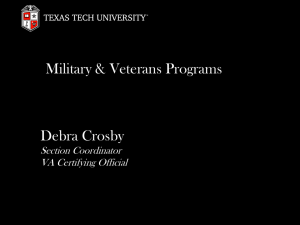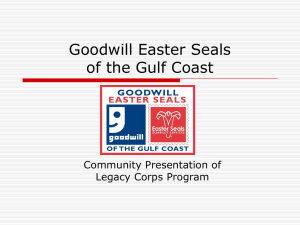VHA HANDBOOK 1601A.02 - National Service Inclusion Project
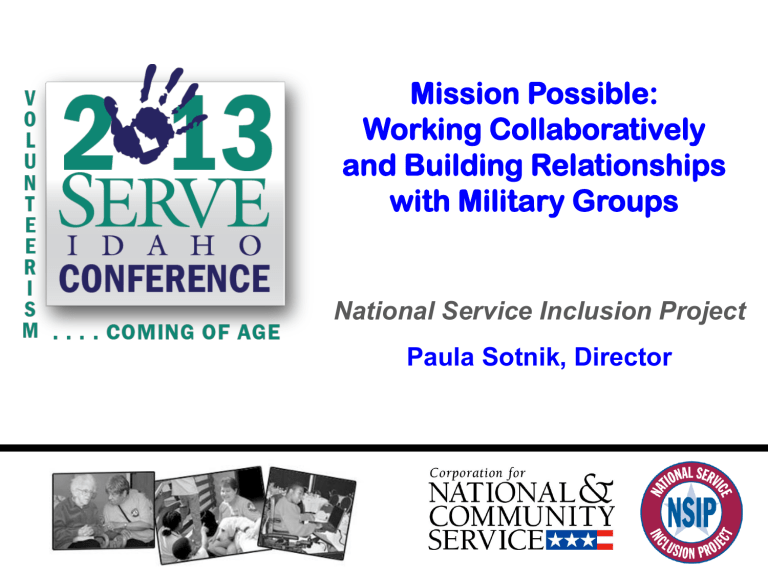
Mission Possible:
Working Collaboratively and Building Relationships with Military Groups
National Service Inclusion Project
Paula Sotnik, Director
www.SERVICEandINCLUSION.org
Toll-free hotline: 888-491-0326 (voice/TTY)
Operation ABLE Community
The Corporation for National and
Community Service (CNCS) is embarking on OAC, a pilot to demonstrate the benefits of a National Service experience for veterans with disabilities who are reentering civilian life. National Service can provide direction and purpose, allowing veterans to continue contributing their skills and expertise to improving lives.
Please share….
Are you engaging veterans and
Wounded Warriors in your programs?
What are the benefits? What are the challenges?
Operation ABLE Community
Most asked question from Vets,
Wounded Warriors and military installation staff,
“How will this impact my benefits?”
If I am on SSI/SSDI and Veterans Benefits, how will national service benefits impact me?
1. OAC researching clear and approved existing guidance on the intersection and develop a paper
2. Identify unanswered questions
3. Hold summit with benefits experts and address unanswered questions and gaps
4. ACTION!
Educate Military about National Service
1. Main goal = military staff offer national service as an option in their transition counseling plans and script
2. Develop a curriculum based on their input and feedback
Educate National Service about the Military
1. Acquaint national service with culture, language, positions, experiences and post military status.
2. Educate national service on how to approach and develop relationships with military and veterans organizations.
3. Identify local and national resources to assist with PTSD and TBI supports
What do you need to successfully engage veterans with disabilities in national and community service?
• outreach and recruitment
• application and interviewing
• supports and retention
What is a Veteran?
“ Someone who, at one point in his life wrote a blank check made payable to 'The United States of America' for an amount of 'up to and including my life
”
. - Unknown
The Department of Veterans Affairs Defines it as:
“
Veteran means a person who served in the active military, naval, or air service and who was discharged or released under conditions other than dishonorable.
”
(VHA HANDBOOK 1601A.02)
Branches of the U.S.
Armed Services
Branch:
• Air Force
• Army
• Coast Guard
• Marine Corps
• Navy
Nick Name:
Airman
Soldier
Guardians
Marine
Sailor
Other:
• Military Personnel
• Dependents
Service Members
Family Members
AIRFORCE
Born: 1947
Primary mission:
To defend the U.S.
(and its interests) through exploitation of air and space
Born: 1775
Primary Mission:
To protect and defend the U.S. (and its interests) by way of ground troops, armor
(tanks), artillery, attack helicopters, tactical nuclear weapons, etc
ARMY
COAST GUARD
Born: 1790
Primary Mission:
To provide law enforcement, boating safety, sea rescue, and illegal immigration control. However, the
President of the U.S. can transfer part or all of the
Coast Guard to the
Department of the Navy in times of conflict
MARINE CORPS
Born: 1775
Primary Mission:
To assault, capture, and control "beach heads," which then provide a route to attack the enemy from almost any direction
Born: 1775
Primary Mission:
To maintain the freedom of the seas
NAVY
NATIONAL GUARD &
AIR NATIONAL GUARD
The Lifestyle You Knew
Exists No More
• Boot camp
• Customs
• Uniforms
• Language
Warning:
Content may be disturbing or harmful to those who have experienced combat or other trauma. The following slides are courtesy of Cornell University, Disability Services Office.
A service member coming home may experience…
Common Disabilities and
Challenges of this Conflict
• PTSD/MST • Body disfigurement
• TBI • Back, shoulder and knee pain
• Impaired vision/Blind
• Hearing loss/Tinnitus
• Loss of limb
• Suicide
• Unemployment
• Stigma
Common Functional Limitations of PTSD
• Detachment, loss of interest, numbing
• Memory deficits
• Avoidance behaviors
• Hyper vigilance
• “ Thousand mile stare ”
• Concentration issues
• Flashbacks
• Anger outbursts
• Sleep issues/night terrors
• Intense guilt
Common Functional
Limitations of TBI
• Difficulty learning and synthesizing new information
• Decreased Processing Speed
• Working memory deficiencies
• Long and short term memory deficiencies
• Poor decision making /problem solving skills
• Unaware of difficulties
• Inability to focus and concentrate
• Fatigue
Common Stereotypes
About Veterans
• All Veterans are in crisis
• All Veterans can obtain VA services
• All Veterans have served in combat
• You have to be in combat to have PTSD
• Veterans are angry
• Veterans are men
Now, to share what we’ve learned to date…
What’s Important to Veterans?
• Understanding why they joined the military and their emotional response to their military service
• Personal goals
• Teamwork, emergency response and deployment
• Vet to Vet
• Respect prior service and leadership skills
• Focus on abilities, not disabilities
• Recruit in person
• Communication
Themes that Resonate with Veterans
• Importance of service and diversity
• Desire to transition personally and professionally
• Feelings of patriotism
• Prioritization of benefits
• Search for new opportunities
• Sense of accomplishment
39
40
41
“ My experience as a volunteer in the AmeriCorps program has given me the will to get out of bed everyday. It has given me the education and the knowledge to understand my disability and it gives me a purpose in life. If you don ’ t have a purpose in life, it is hard to get out of bed every morning ”
-anonymous veteran who served in AmeriCorps
Common Questions You Will Encounter…
•How many terms of service may someone serve?
•May a member serve while still serving in the Army?
•Where are service opportunities in my area?
•What if I have a less than honorable discharge?
•Can someone support a family on an AmeriCorps living allowance? What are the other benefits and WIIFM?
•What if I have VA appointments?
Best Practices
• Educate yourself on the military
• Be aware of mental health challenges and be knowledgeable of where to refer if needed
• Understand that the transition back into civilian life is again another culture shock and the more structured the program the better the Veteran will do
• If certain steps need to be taken, have a list of the steps for the Veteran to follow and have point of contacts for them to reach out to
• Actively listen to the Veteran ’ s needs -
Motivational Interviewing (OARS)
• Identify the chain of command
Best Practices, Cont.
• Educate the Veteran on what services you offer and how the Veteran (and family) will benefit from your program
• Be straight up, if your program will not fit their ’ needs let them know
• Become acquainted with Veteran resources in the community these take many forms
– DAV, VA, Student Veteran Organizations,
American Legion, VFW
• Keep in mind that accommodations may be needed but the Veteran will be apprehensive about asking
• Give the Veteran an opportunity to lead
• Create a Veterans mentorship group
• Lastly, do not talk about military service unless there are certain questions that need to be answered or the Veteran brings it up in conversation
•Engaging Veterans with Disabilities in National Service Initiative http://www.serviceandinclusion.org/
•CNCS Veterans Corps http://www.nationalservice.gov/about/serveamerica/veterans.asp
•Operation TBI Freedom www.operationtbifreedom.org
•America ’ s Heroes at Work www.americasheroesatwork.gov
•Invisible Wounds: Serving Service Members and Veterans with PTSD and
TBI http://www.disabilityrightsoregon.org/search?SearchableText=invisi ble+wounds
•Recovering from Mild Traumatic Brain Injury (MTBI) A Handbook of Hope for Our Military Warriors and Their Families www.braininjuryhopefoundation.org
•National Service Inclusion Project (NSIP) www.serviceandinclusion.org/veterans

